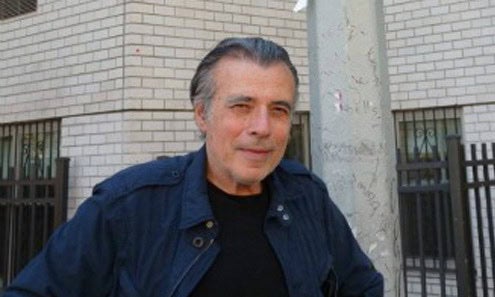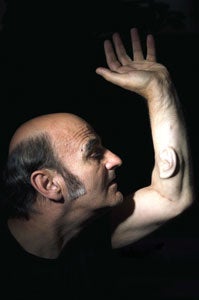
Arthur I. Miller is a professor emeritus of history and philosophy of science at University College London. Author of the fascinating books Einstein, Picasso and Colliding Worlds, he is an expert on the science of creativity and on the contemporary connections of art, science, and technology. I met Dr. Miller on a cold London day at the Wellcome Center’s café, where we discussed some of the ideas in his interdisciplinary writing.
BOJANA GINN: Your book Einstein, Picasso: Space, Time and Beauty that Causes Havoc was nominated for a Pulitzer Prize. In it you describe two important discoveries that happened simultaneously, one in in art, one in science. Can you tell us about them?
ARTHUR MILLER: What always was of interest to me concerning Einstein and Picasso is that they were born within two years of each other—Einstein in 1879, Picasso 1881—and they both made their first great discoveries at about the same time: Einstein discovered the Theory of Relativity in 1905, and Picasso created Les Demoiselles d’Avignon in 1907, which contains the seeds of Cubism. Yet they did not know anything about each other, and actually they never met throughout their entire lives. What I found is that they were both swept up by the intellectual tidal wave that swept across Europe: the avant-garde, the principle problem of which was the nature of space and time. Einstein explored temporal simultaneity and Picasso spatial simultaneity, which is essentially Cubism. In the very first page of the relativity paper, Einstein makes it clear that he has no qualms with the equations of the physics of 1905 but with the way that scientists interpreted them, in ways that implied asymmetries that were not inherent in nature. He recalled that he found this situation unbearable. He found their sources were inessential concepts and redundant explanations and turned to a minimalist aesthetic to pare them away. The result was the 1905 Theory of Relativity—a response to his aesthetic discontents.
Picasso was inspired by the developments in science, technology and mathematics. This is evident everywhere in his 1907 painting Les Demoiselles d’Avignon. Concerning science, there were the X-rays, which he interpreted as what you see is not necessarily what you get. That is clear from the faces and forms of the five demoiselles. Concerning technology, it was cinematography and photography—you can see the setup of Les Demoiselles d’Avignon is essentially a motion picture in five frames with increasing geometrization as you move from left to right. And we see mathematics in forms that he reduced to geometry, which was his aesthetic choice. Note especially the face of the demoiselle on the far right, the most interesting face. It’s represented simultaneously in two perspectives: front view and side view. This is the spatial simultaneity—two perspectives at once. So at the beginning of the 20th century scientists were beginning to think like artists and artists like scientists. And that is what I wanted to bring out in Einstein, Picasso.
BG: Your more recent book, Colliding Worlds: How Cutting-Edge Science is Redefining Contemporary Art, starts with a very interesting event that happened in the ’60s in New York called “9 Evenings: Theater and Engineering.” Who were the protagonists and what was this show about?
AM: Okay, just a little background. Previous to the early 1960s, artists were influenced by science, technology, and mathematics, as were Picasso, Duchamp, Kandinsky, Malevich, and Mondrian. They used the ideas of science and technology but not the mediums themselves. In the beginning of the 1960s, a lot of electronic equipment became available and artists wanted to use it. At that time in New York, Fourth Avenue and 10th Street was the haunt of Robert Rauschenberg, Robert Motherwell, Andy Warhol, John Cage, and Jean Tinguely, among others. The critical mass was formed with the appearance of Billy Klüver, whose day job was as a scientist at Bell Labs, the American Telegraph and Telephone’s highly innovative research laboratory in Murray Hill, New Jersey. He was no ordinary scientist, moving as he did between the worlds of science and art. He collaborated individually in the early 1960s with all of those artists. In 1966, he decided that it was a time for a large-scale collaboration, so he brought 30 scientists down from Bell Labs to the East Village where he teamed them up with 10 artists.
The culmination was the show “9 Evenings: Theater and Engineering.” As Klüver recalled, the inspiration was Rauschenberg, but the star was Cage. Rauschenberg’s performance was a tennis game in which each time the ball was hit, one light in the space went out. Cage’s was a sound show in which he piped in sounds actually occurring at that moment, from 10 telephone lines, from hotel kitchens, the ASPCA, police and marine radio bands. He also wanted sounds from outer space and he could have had them because two scientists from Bell Labs the year before had discovered the echo of the Big Bang, but they couldn’t hook up a phone line from their lab into the 69th Regiment Armory, where the show was held. And it was not totally by coincidence that the show was held there, because in 1913 there was a big exhibition where avant-garde art from France was introduced into the United States.

BG: So, like you said, in the ’60s and ’70s there were plenty of collaborations between artists, scientists, and engineers. But then something happened and the interest died out?
AM: Yes, as far as I can discern, it was due to the Vietnam War and the association of science and technology with the military. That turned lots of artists off. And so there was a gap in the late ’70s, ’80s, until the ’90s. Then collaborations picked up owing to dramatic developments in biotechnology: in vitro fertilization, FMRI scans, and organ transplants. Artists could not afford not to be interested in these new developments that went right to the core of the meaning of life. Artists found themselves learning these subjects which offered them a medium to explore anew emotions and nature, something that had always been the artist’s purview, with tools that went beyond paint and chisel.
BG: Another fascinating story found in Colliding Worlds is the story of Jackson Pollock’s fractals, or how mathematics helped solve an art scandal.
AM: Yes, in 2002 a number of paintings were found in Jackson Pollock’s drip style. A highly regarded art historian declared that they were the real thing. Some of the paintings were sold for around $40 million. And then two art connoisseurs who were members of the Pollock-Krasner Authentication Board (as was the art historian involved) had their doubts. An investigation began, joined by newspaper reporters as well other art historians. Interesting, and quite by accident, I met Richard Taylor, a physicist whose research specialty is fractals. He is an artist as well. In fact, he has an MA in art. He was always fascinated by Jackson Pollock and found that many signature Jackson Pollocks display fractal properties.
The Pollock-Krasner Foundation asked him to do a fractal analysis of the newly discovered paintings. His results showed that they did not seem to be by Pollock. Taylor emphasized that pigment analysis was also needed for verification. The pigment analysis was done by a number of highly competent people who found that pigments in the paintings were made after Pollock’s death. Now reputations were on the line, and so was money already spent. This became a very ugly affair. But an important point here is that there are three legs, so to speak, to which the art world turns for verification of a painting: the art historian who looks into the provenance of the painting; the connoisseur who eyeballs the painting and with a great deal of experience can tell you with great certainty whether a painting is the real thing or not. And now there is a third leg: science and technology—technology by means of spectroscopic analysis that figuratively can drill into a painting to ascertain when pigments were manufactured. But now there is real science as well: the mathematics of fractal analysis. In this case of Pollock’s art, pigment analysis carried the day. But if it had proved wanting, then fractals would have been brought to bear.

BG: In 2012 you curated the show “Art & Science: Merging Art & Science to Make a Revolutionary New Art Movement.” Can you tell us about that experience?
AM: It was actually my second experience in curating. The first one was in Berlin when I actually collaborated with an artist. The show “Art & Science: Merging Art & Science to Make a Revolutionary New Art Movement ” included very well-known bio-artists, such as Stelarc, Nina Sellars, Oron Catts, Ionat Zurr, and others. These are people who are creating a new form of art. The show was very well received. There were panels which I chaired. The first one included Stelarc, Oron Katts and Nina Sellars. In the course of it, I talked about science-influenced art, which is what I assumed they were doing, and they got very upset about it. Did I dare insinuate a hierarchy here? I was surprised because I never meant anything along those lines. That opened up my eyes to how some artists view the interplay between art and science. Also, some artists believe that they are using science for their art like they do paint from a can. The interplay between art, science, and technology is a bottomless subject, like a black hole. So, for the purposes of my book, I had to demarcate what I really wanted to do. I decided to deal with only those artists whose work reflected back onto science. These are artists who collaborate with scientists and/or seriously try to learn basic concepts of science. So that eliminated most of the people who do art/science—that is, those artists who essentially illustrate science or create art based on science, and that is all fine and good because they sometime produce dazzling and beautiful works. But it is not the sort of artist that interests me.

BG: Lately we hear and read a lot about bio-art. What are the most fascinating examples of bio-art that you have seen?
AM: Well, two jump out immediately. The first one is by Stelarc who recently had a left ear imbedded in his left arm. It is not an ear like on your head. Stelarc’s stem cells were woven into a biodegradable frame and then implanted into his arm in a series of operations still ongoing. Eventually there will be a Bluetooth device inserted and connected to the web. Then there is Eduardo Kac’s fluorescent bunny, Alba, which underwent gene therapy with the insertion of a fluorescent protein gene of a jellyfish that glows green when bathed in blue light, just like Alba did. Kac then instigated a debate on the ethics of genetic engineering, the ethics of producing living forms that had not existed before.
BG: What do you see as the future of art?
AM: I believe that art, science and technology as we know them today will disappear, fused into a third culture—the new avant-garde. Denizens of this third culture are already with us in media art, sound art, and data visualization art. And so will biology and physics fuse with art. In the future, I envisage denizens of the third culture sitting in front of computers with as yet undreamt of architectures producing theories that generate images that have truth-value and are aesthetic in a new definition of that term.




